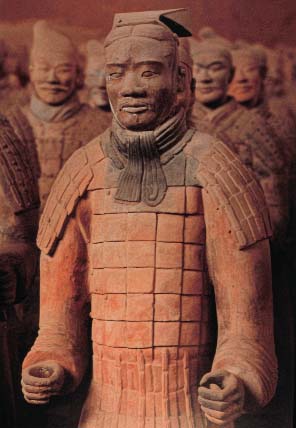 Introduction
to Archaeology and Palaeoanthropology:
Introduction
to Archaeology and Palaeoanthropology:

Humanity's Journeys
Dr. Kathryn Denning
Anth 2140, Sept 2005 - Apr 2006
28 Feb 2006... Hi!
Plan for the day
1 Course business/ announcements...
2 Asia, Guns/Germs/Steel, and Ontario
Reading and Assignments
Last week, Feb 21: Fagan Ch 13, Early Asian Civilizations AND ONLINE: Jared Diamond: Why Did Human History Unfold Differently On Different Continents For The Last 13,000 Years? /www.edge.org/3rd_culture/diamond/diamond_p1.html
For today, Feb 28: Precontact Ontario www.adamsheritage.com/pre/preont1.htm Read each section (tabs along side)
In tutorial tomorrow, Mar 1: MUSEUM ASSIGNMENT IS DUE (posted here) and you'll be discussing Guns, Germs, and Steel, based on Jared Diamond's piece which you read here: www.edge.org/3rd_culture/diamond/diamond_p1.html)
Mar 8 in tutorial - Quiz #5. Review notes here. Will cover: Fagan ch 12, 13, 15, online readings from Diamond and on Ontario
Next week's readings - Fagan Ch 14 and Ch 15, 364-416: Maize, Pueblos, and Mound Builders, and Mesoamerican Civilizations
Recalling these generalities about civilizations...
Food production is key. It may have emerged for different reasons ( a need for surplus/luxury, e.g. competitive feasting, or maybe a need for food security/survival when population increased) ... but the general result is an increase in social complexity and an increase in landscape modification. In the past, labour was human and animal (not machine and chemical), and labour requirements were therefore vast.
"Civilizations"
- arose independently in multiple parts of the world (an astonishing fact in itself!) - Nile Valley, Meopotamia, Indus Valley, North China, Mesoamerica, Andean region. (Perhaps more complex societies yet to be discovered, but a full-blown civilization would be a big surprise.)
civiliations are state-organized societies (archaeological ones are pre-industrial, i.e. before fossil fuels)
They have:
- cities (pop of 5 000 or more; dense; centralized with division of labour, depend on hinterland for food, monumental architecture, centralized government)... you can have a state without a city, but not really a city without a state
- economies based on centralized accumulation of capital and social status through tribute and taxation
- advances towards formal record keeping, science, mathematics, and some form of written script
- monumental architecture and impressive public buildings
- some form of state religion, often with a deified ruler or ruling class
(Fagan Ch 12)
We've looked briefly at Mesopotamia and Egypt. We will be looking at New World civs soon. Today - a little on Asian civs. n.b. we are leaving out MANY!
South Asia and China
Early Civilizations in the Indus Valley
First, knowing where we are...

Note: India, Africa, Asia, Europe.
Arabian Sea, Indian Ocean, Bay of Bengal, Indus and Ganges.

Top left: Black Sea, then Caspian Sea.
Bottom left: Mediterranean Sea, then Red Sea, then Persian Gulf/Tigris/Euphrates/Mesopotamia.
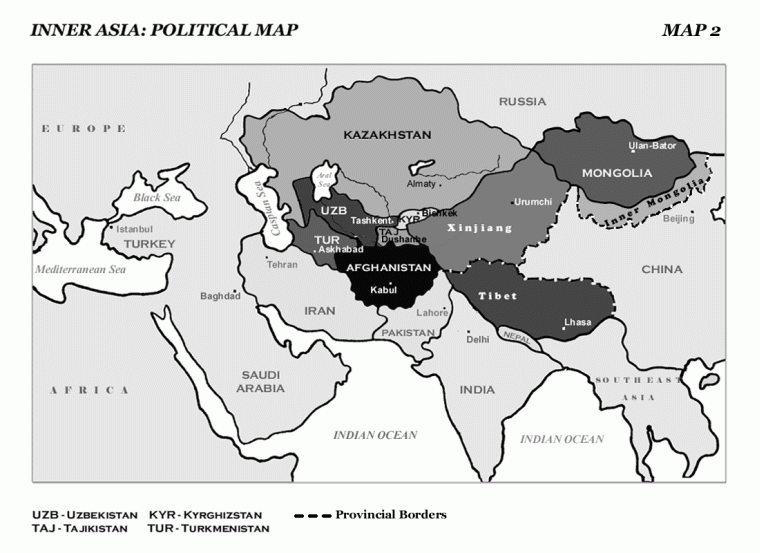
Note the current political boundaries.
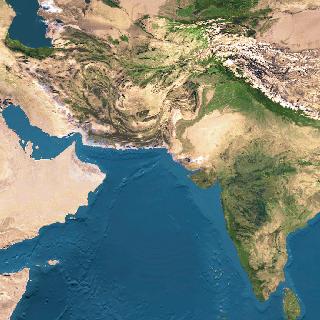
Note the geographical features: Himalayas, Ganges R, Indus R.
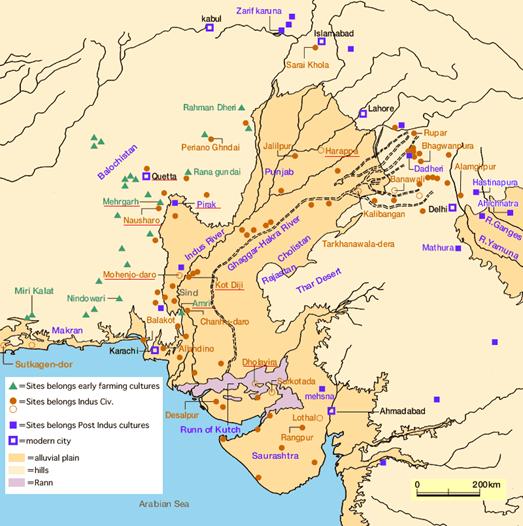
Note: Extent of alluvial plain, modern cities like Karachi, Lahore, Islamabad, Kabul, as well as Indus civilization cities like Mohenjodaro, Harappa
Q: Why does geography matter when we are considering the origins and development of ancient civilizations?
Some key features of Harappan civilization
Timing:
-started by 3000 BC
-"mature Harappan" 2500-2050 BC
- collapse c. 2000 BC.
Main sites:
Mehrgarh (v. early, starting 6000 BC, domesticated plants and animals (wheat, barley, sheep, goats, cattle), village with strong regional trade
Harappan, e.g. Nindowari site, 2600-2200 BC. Mohenjodaro and Harappa
Cities: Big! up to 40 000 for Mohenjodaro
Technology and Trade: Craft specialization
Political and Social Organization and Religion - Complex but not well understood.
Writing - not well understood.


Examples of the undeciphered Indus Valley script.
The "Unicorn Seal" of fired steatite, from Mohenjo-daro, c. 2000 BCE and another seal impression.
Images borrowed from http://www.harappa.com/seal/seal1.html and http://www.harappa.com/seal/seal3.html

Dancer figurine, bronze. Mohenjodaro. (10.2 cm high)
e.g.s of Indus script: http://www.harappa.com/indus/31.html
http://www.harappa.com/script/
Tour the Indus Valley! www.harappa.com/indus/indus0.html
www.harappa.com/indus/slideindex.html
The Qin: First Chinese Empire
Qin Emperor Shihuangdi 221-210 BC
- unified China at the end of the Warring States period,
- destroyed previous records
- massive road building program (one over 7 500 km long!)
- Great Wall
- empire collapsed shortly after his death
Tomb of the Emperor ("Terracotta Army")
mound - 50 metres high, inside massive compound
- 700 000 convicts conscripted to build the complex; artisans and concubines were 'sacrificed' by the emperor's son when the job was done, to keep the security details secret
- multiple pits, with a total of about 6 - 8 000 warriors of various ranks, all in formation - no 2 faces the same, each beautifully made - originally carried weapons but these were looted in antiquity shortly after his death - fantastic for archaeologists
- looters set fire to it and the ceiling collapsed, leaving the tomb covered in damp soil
- There might be even more of them down there!
Terracotta Army: An interesting case study in terms of preservation.
It's a World Heritage Site, important tourist site.
Current Issues:
- mould - 40 kinds of it - attacking 1400 of the 8000 warriors - partly as a result of tourism bringing in new spores - a pharmaceutical company has been working on the solution
- cracking - since they're now exposed to the air, their external glaze has started to crumble - a very sophisticated preservation technique is now being used to preserve them - using plastic molecules and a particle accelerator
- the three farmers who discovered it in 1974 want recognition that they found it (and possibly this will come with some monetary benefits), but the Museum isn't granting it
- also, possible privatization (Are Heritage sites the kind of thing that should be traded on Stock Exchanges?)
- not digging...
Three news items on the current state of the Terracotta Army:
1.
http://www.nature.com/nsu/031124/031124-7.html
2.
http://news.bbc.co.uk/2/hi/asia-pacific/3320691.stm
3.
http://news.bbc.co.uk/2/hi/asia-pacific/930136.stm
Exhibition:
http://www.imh.org/imh/china/index.html
This page, especially the images:
http://www.nga.gov/education/chinatp_pt4.htm
Images here:
http://www.art-and-archaeology.com/timelines/china/qin-han.html
China: The Middle Kingdom. Site by Richard Hooker.
http://www.wsu.edu/~dee/CHEMPIRE/CHEMPIRE.HTM
Han Empire
206 BC - AD 220
Coopted previous regime's political machinery.
Abundant archaeological remains (more so than earlier groups), but usually from tombs -- luxury and everyday stuff, terracotta models of buildings and other models showing livestock, agricultural equipment, and brick reliefs too.
Tremendous emphasis archaeologically on the rich
Aristocratic tombs include the most famous tombs in all of archaeology, including mummies (astonishing preservation) e.g. tomb of Marquis Dai and his wife. Mawangdui tomb - one of best preserved Han tombs ever, wife of Dai of Changsha, d. 160 BC, wooden burial chamber perfectly preserved by layers of charcoal and white clay, and the body was perfectly preserved - cause of death - heart attack brought on by pain of gallstones
Recent discoveries include more pottery armies -- but little! only about 2 feet tall -- and including animals! oxen, dogs, sheep, pigs -- numbers of figures far higher, (40 000?) Chariots, equipment, grain stores. Soldiers had miniature weapons - iron swords, wooden crossbows. Figures painted and dressed in silk originally.
-------------------------------------
Angkor
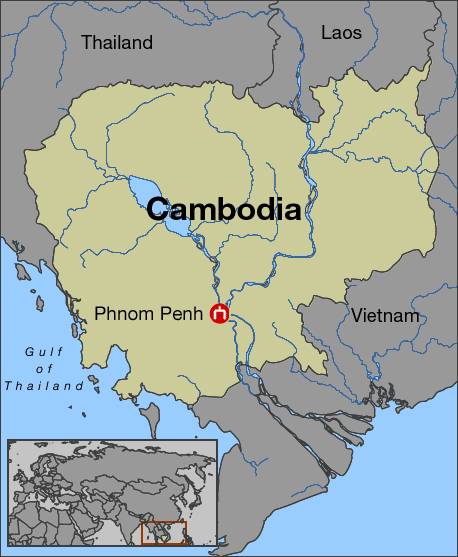
Influence from India and China
Very basic timeline here: http://mcel.pacificu.edu/as/students/straussj2/timeline.html
and more here: http://news.bbc.co.uk/2/hi/asia-pacific/country_profiles/1244006.stm
Cambodia is currently devastated economically and relies very heavily on tourism at places like Angkor Wat. Huge problem with illicit antiquities trade. (We'll return to this case study.)
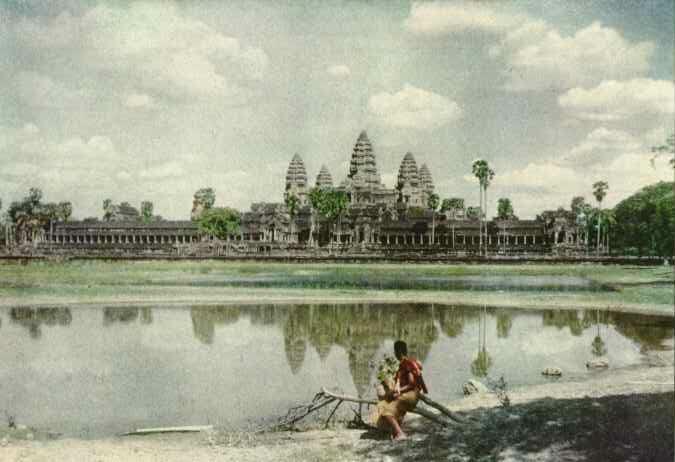
Photo of Angkor Wat from the 1920s. Temple, mausoleum, and astronomical observatory.
Angkor state: AD 802-1430
n.b. Divine kings e.g. Jayavarman II
"Khmers' unique form of kingship produced a society that carried the cult of wealth, luxury, and divine monarchy to amazing extremes." Supported by extensive lower class/slaves.
Angkor Wat: Temple, mausoleum, and astronomical observatory. The largest religious building in the world. Huge complex. Belief system directly represented in the architecture. Tallest tower represents summit of Mt. Meru (cosmic mountain), other towers represent its other peaks. Decorations: warriors, celestial maidens.
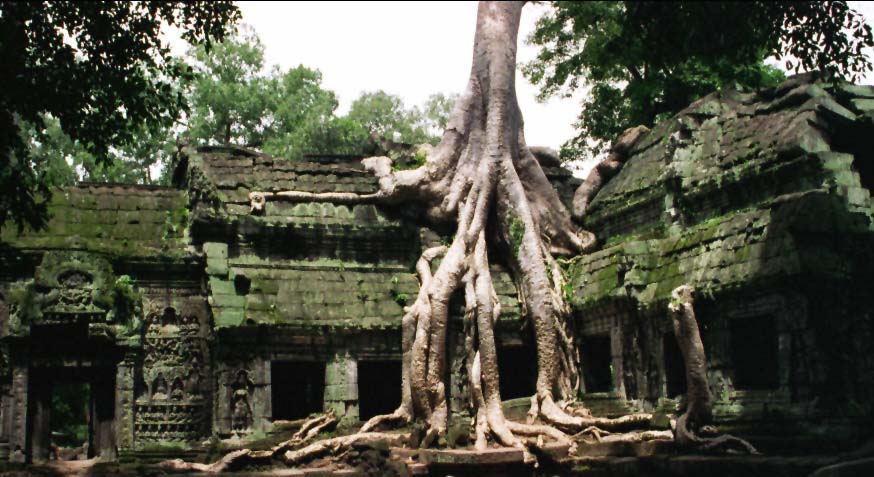
Ta Phrom, in the Angkor complex
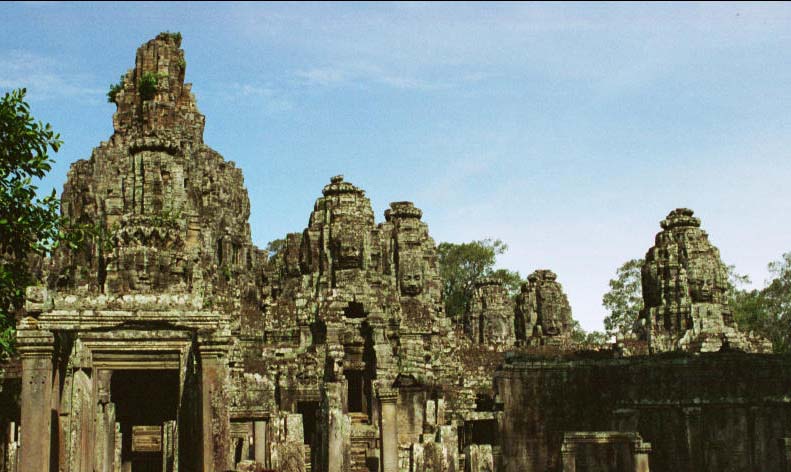
Bayon temple: faces pointing in cardinal directions
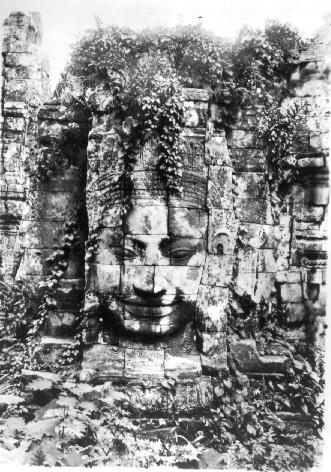
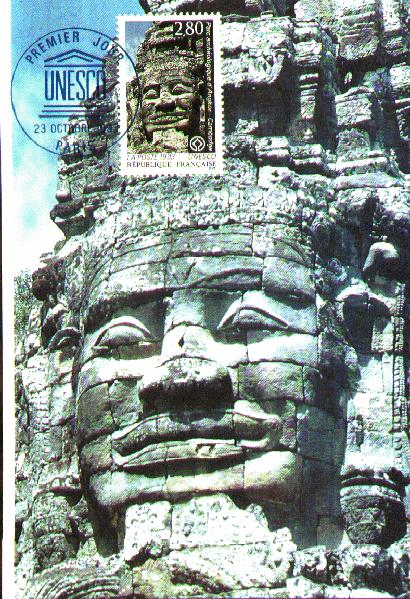
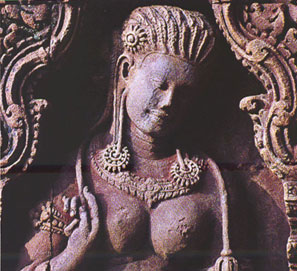
Jared Diamond's Guns, Germs and Steel.
- work of immense historical scope, seeking to answer the question How did things come to be this way? -- that is, a world with profound inequalities. He specifically asks "Why did wealth and power become distributed as they now are, rather than in some other way?"
He writes:
"This book attempts to provide a short history of everybody for the last 13 000 years. The question motivating the book is: Why did history unfold differently on different continents? In case this question immediately makes you shudder at the thought that you are about to read a racist treatise, you aren't: as you will see, the answers to the question don't involve human racial differences at all. The books' emphasis is on the search for ultimate explanations, and on pushing back the chain of historical causation as far as possible."
- seeks to examine histories of societies besides those of western Eurasia, to push back in time beyond the origins of written history, and to really ask why western Eurasian societies have had such disproportionate impact globally.
"Why were those societies the ones that became disproportionately powerful and innovative? The usual answers to that question involve proximate forces, such as the rise of capitalism, mercantilism, scientific inquiry, technology, and nasty germs that killed people of other continents when they came into contact with western Eurasians. But why did those ingredients of conquest arise in western Eurasia, and arise elsewhere only to a lesser degree or not at all?"
(Diamond, Guns, Germs and Steel, 1997/9: 9-11)
So why did history unfold so differently on different continents....?
... if it isn't to do with biological differences in human populations?
Diamond's Key Ideas:
- it's not to do with innate and deep differences between us in human biology
- it's more to do with the environments our societies developed in:
- animals and plants that could be domesticated
- shape of continent (north-south or east-west axis)
- relative geographic isolation (island or not)
"The broadest pattern of history — namely, the differences between human societies on different continents — seems to me to be attributable to differences among continental environments, and not to biological differences among peoples themselves. In particular, the availability of wild plant and animal species suitable for domestication, and the ease with which those species could spread without encountering unsuitable climates, contributed decisively to the varying rates of rise of agriculture and herding, which in turn contributed decisively to the rise of human population numbers, population densities, and food surpluses, which in turn contributed decisively to the development of epidemic infectious diseases, writing, technology, and political organization." Diamond -www.edge.org/3rd_culture/diamond/diamond_p6.html
Abstracted: http://www.agron.iastate.edu/courses/agron342/diamondindex.html
Jared Diamond: "Evolution, Consequences and Future of Plant and Animal Domestication" http://www.hort.purdue.edu/newcrop/history/lecture03/r_3-2.html
Archaeology of Ontario
www.adamsheritage.com/pre/preont1.htm
Different groups, languages, lifeways
Changing landscapes and climate over time
Chronology
Glaciation
PalaeoIndian - 10 000 BCE and earlier
Archaic - Early, Middle, Late - around 8 000 to 1 000 BCE
Woodland - Early, Middle, Late - 1 000 BCE to 1000 AD/CE (pottery, farming)
Iroquoian - AD/CE 1000 - contact
Historic (contact) - Cartier 1534 onwards

CURRENT MOHAWK TERRITORIES

Links:
Seed-Barker site: http://www.rom.on.ca/digs/seedbarker/ http://www.chass.utoronto.ca/anthropology/Exhibit/seedbark.htm
Prehistory of Ontario www.adamsheritage.com/pre/preont1.htm
Iroquoian Longhouse: http://www.rom.on.ca/digs/longhouse/